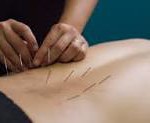Dry Needling: What is it and How does it work?
Dry needling involves the insertion of very thin needs into areas of painful muscular, ligamentous, and tendinous damage. Electric stimulation may then be attached to the needle to enhance its effect. The insertion of the needle creates a sensation of aching, which indicates the the area of damage has been located. Dry needling interrupts the cycle of pain and increases circulation to the area of injury. It is a modern technique that has an historical basis in acupuncture.
It is remarkably effective and very safe for managing the following conditions:
Low back pain
Sciatica
Neck and upper back pain
Headaches
Rotator cuff injuries in the shoulder
Tendinitis in the elbow, shoulder, and hip
Knee pain
Hip pain
Shin splints
Plantar fascitis
Achilles tendinitis
Dry needling can be utilized instead of injections of cortisone. Cortisone weakens tendons and leaves them vulnerable to further tearing and damage. Research shows us that just the needling of the tissue is very effective at interrupting pain and promoting improved circulation. Only in circumstances when this approach is ineffective should shots of cortisone be considered.
How Dry Needling Improves Function and Reduces Pain
Dry Needling of muscular trigger points causes relaxation and release of the spasm through disruption of the motor endplate. Tiny injuries created by the needle insertion cause a local healing response in the dysfunctional, painful tissue, which restores normal function through the natural healing process.
Dry Needling stimulates neural pathways which blocks pain by disrupting pain messages being sent to the central nervous system.
The pain control process occurs by:
*Opiod suppression at the spinal cord level.
*The Gate Theory of pain
*Pain messages encounter “nerve gates” in the spinal cord that open or close depending upon a number of factors . When the gates are opening, pain messages “get through” and pain can be intense. When the gates close, pain messages are prevented from reaching the brain and may not even be experienced.
*Activating neurotransmitters in the central nervous system, which contribute to a systemic pain inhibiting effect, and this neurotransmitter response extends the therapeutic benefit to other areas of the body.
*Dry Needling causes a local chemically mediated response through the release of Bradykinin, Substance P, and other body proteins and neurotransmitters, which block the transmission of pain messages.
Dry Needling, combined with deep tissue massage and the correction of muscular imbalances, has been shown to help the following conditions:
Lower back pain
Neck and Upper Back Pain
Sciatica
Piriformis Syndrome
Hip Pain
Acute and chronic tendonitis
Athletic and sports-related overuse injuries
Post- surgical pain
Post-traumatic injuries, motor vehicle accidents, and work related injuries
Chronic pain conditions
Headaches and whiplash
Dr. Smith has been using Dry Needling in addition to Acupuncture for over 20 years. She received her certification in Acupuncture in 1993.









